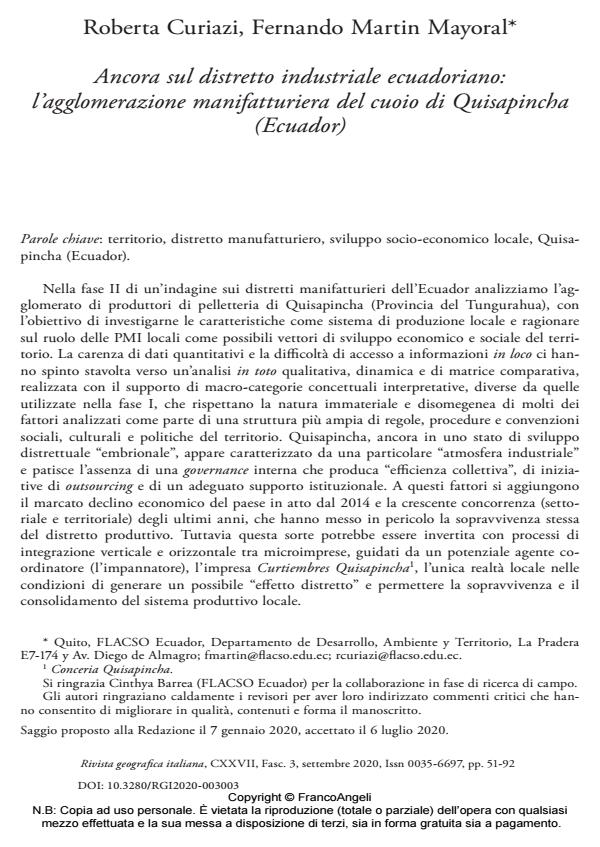More on the Ecuadorian industrial district: the leather manufacturing cluster in Quisapincha (Ecuador)
Journal title RIVISTA GEOGRAFICA ITALIANA
Author/s Roberta Curiazi, Fernando Martin Mayoral
Publishing Year 2020 Issue 2020/3
Language Italian Pages 42 P. 51-92 File size 517 KB
DOI 10.3280/RGI2020-003003
DOI is like a bar code for intellectual property: to have more infomation
click here
Below, you can see the article first page
If you want to buy this article in PDF format, you can do it, following the instructions to buy download credits

FrancoAngeli is member of Publishers International Linking Association, Inc (PILA), a not-for-profit association which run the CrossRef service enabling links to and from online scholarly content.
In the second stage of an investigation on the manufacturing districts of Ecuador we analyze the cluster of leather goods producers of Quisapincha (Tungurahua Province), with the aim of investigating its characteristics as a local productive system, and to think about the role of local SMEs as vectors of economic and social development of the territory. The lack of quantitative data, and the difficulty of accessing certain information in loco, this time prompted us to a qualitatively analysis, carried out with the support of analytical and conceptual macro-categories, different from those previously applied in phase I, which respect the immaterial and inhomegenic nature of many of the factors analyzed as a part of a wider structure of rules, procedures and social, cultural and political conventions of the territory. Quisapincha, still in a state of "embryonic" district development, appears to be characterized by a "particular industrial atmosphere" and suffers the absence of internal governance that produces "collective efficiency", of outsourcing initiatives, and of an adequate institutional support. To these factors, the marked economic decline of the country since 2014 and the growing competition (sectoral and territorial) in recent years must be added, which have endangered the very survival of the district. However, this fate could be reversed with vertical and horizontal integration processes between micro-enterprises led by a potential coordinating agent (the impannatore), represented by the Curtiembres Quisapincha company, the only reality in the conditions to generate a possible "district effect" and to allow the survival and consolidation of the local productive system.
Keywords: Territory, manufacturing district, local socio-economic development, Quisapincha (Ecuador).
Roberta Curiazi, Fernando Martin Mayoral, Ancora sul distretto industriale ecuadoriano: l’agglomerazione manifatturiera del cuoio di Quisapincha (Ecuador) in "RIVISTA GEOGRAFICA ITALIANA" 3/2020, pp 51-92, DOI: 10.3280/RGI2020-003003